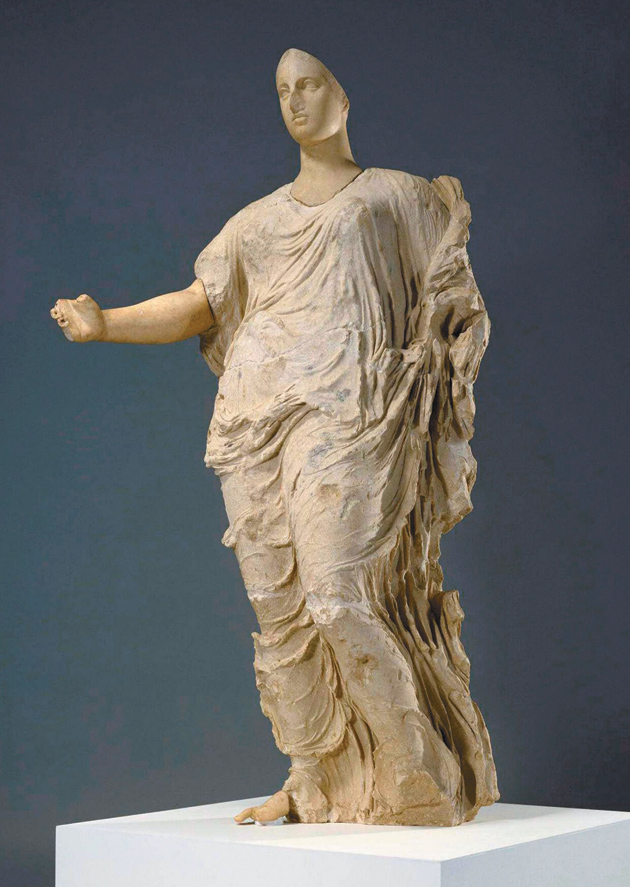In response to:
What Went Wrong at the Getty from the June 23, 2011 issue
To the Editors:
Hugh Eakin’s review of our book Chasing Aphrodite: The Hunt for Looted Antiquities at the World’s Richest Museum [NYR, June 23] was begrudgingly complimentary in places, but also curiously littered with contradictions and a derisive tone that went unsupported by any argument of substance.
The review opens with a straw man argument. Eakin claims our goal was “to debunk the notion that art museums might have some legitimate reason for collecting art from the ancient past.” This is false. As the book makes clear, we have no objection to museums collecting ancient art—legally.
Eakin claims we do not support our statement that, by fueling the black market, museums have destroyed more knowledge than they have preserved. Yet there is no better illustration of our case than the object at the center of the book, the Getty’s cult statue of Aphrodite. Like other American museums, the Getty was so intent on keeping this illicit beauty that time and again it was willing to sacrifice the truth.
Such contortions abound in Eakin’s review. He calls our portrait of the Getty “cynical,” then says no institution was more suited “to Verres-like scrutiny.” He calls our focus on former Getty antiquities curator Marion True “puzzling,” yet Eakin calls her trial “unprecedented” and, in 2007, wrote a ten-thousand-word profile of her for The New Yorker. Eakin is critical of Italian officials for “waging their battle through the press,” but was a frequent benefactor of such leaks in his own coverage of the scandal for The New York Times, where he was often competing with the authors of the book he now reviews. (We leave it to your readers to decide if this history, which Eakin fails to mention, colored his review.)
Eakin says we encourage readers “to infer skullduggery in routine museum dealings,” but then cites the “vast body of internal memoranda, legal briefs, and museum correspondence” we marshal to show bribery, forgery, tax fraud, smuggling, and dishonesty by museum officials. Eakin claims that these documents were “leaked from the office of the Getty’s in-house counsel,” wrongly assuming that documents generated in the general counsel’s office must have been leaked from there. In fact, the internal records cited in our book span four decades and were circulated widely, as suggested by our more than three hundred footnotes.
Our more complete response to Eakin’s review can be found at ChasingAphrodite .com. In this limited space, suffice it to say that, despite his petulant tone, Eakin fails to find a single matter of factual dispute in our 360-page book. Rather, he relies on innuendo to convey what is ultimately a difference of opinion.
His conclusion is that Chasing Aphrodite is “an important book, though not, perhaps, in the way [we] intend.” We’re left to speculate about the “quite different interpretation” Eakin thinks can be drawn from the facts. His only hint comes in his final paragraphs, when he calls the return of more than half a billion dollars’ worth of looted antiquities “a victory…for the approach endorsed by collecting museums.”
Based on that logic, we suspect Eakin thinks the Battle of Gettysburg was likewise a victory for the South.
Jason Felch
Los Angeles, California
Ralph Frammolino
Dhaka, Bangladesh
Hugh Eakin replies:
Jason Felch and Ralph Frammolino are disappointed that my review of their book was not wholly complimentary. Let me be clear: there is nothing grudging about my admiration for their extraordinary revelations about the Getty Museum. Contrary to what they suggest, neither I nor any other reporter could compete with them because their information was, as I wrote, all their own. (Their desire to protect the provenance of their information is understandable, but key documents in their scoops about the Getty, like the cryptic 1987 notes by John Walsh, then director of the Getty Museum, saying “we know it’s stolen” and the confidential 2001 memo advising Getty Trust President Barry Munitz not to volunteer information to the Italian authorities, were not “circulated widely.” These documents, which along with others the authors cite are omitted from their book, were unknown to senior curatorial staff. Among other principal sources, the cooperation with the authors by a member of the general counsel’s office, which conducted an extensive internal review of the museum’s antiquities files, is also indicated by their own account.)
Nor would I describe the Italian strategy to share prosecution files with the press—a strategy officials in Rome were quite open about—as anything short of brilliant: it achieved, as I wrote, “improbable” results. In both cases, however, the leaking of information to journalists places a burden on them to countercheck the claims being made.
Take the Aphrodite. In their book, Felch and Frammolino write that, as early as 1992, a Carabinieri investigator had been taken “to the site in Morgantina where the statue had been found” and that the Carabinieri believed they knew “how [it] had left the country, and who was responsible for the crime.” Yet the museum, as Felch and Frammolino maintain in their letter, “was so intent on keeping this illicit beauty that time and again it was willing to sacrifice the truth.”
Advertisement
In the longer version of their letter on their website, they go further, claiming that “time and again” the museum rebuffed attempts to study the statue and that “only after the Getty agreed to return the statue to Sicily” in 2007 “did it invite scholars to begin the arduous process of reconstructing that lost history.” They also write that “the Getty even refused to obtain missing fragments from the statue from the man they publicly claimed was its original owner.”
Here are some contradictory facts. Italian authorities did not share with the Getty the findings of their—ultimately inconclusive—Aphrodite investigation: not in 1992 or even in 1998, when Marion True spoke about the statue before an audience of Carabinieri officials in Rome. Nor did the Italian government make any formal request for the statue until November 2004, when the prosecutor Paolo Giorgio Ferri belatedly included it in his then four-year-old investigation of True.
With hindsight, it is regrettable that the Getty did not follow up on the unsolicited 1996 letter to then Getty president and CEO Harold Williams from Renzo Canavesi, a Swiss national who—eight years after the statue was purchased from the London art dealer Robin Symes—suddenly identified himself as its former owner and claimed he still had missing fragments of it. But at the time, Getty officials had not been informed of the Italian investigation of Canavesi, who, far from being “publicly claimed” by the museum as the “original owner,” was unknown to True or anyone else at the museum.
Regarding research on the statue, in the fall of 1988, Adriano La Regina, the archaeological superintendent of Rome, traveled to Los Angeles to inspect it on behalf of the Italian culture ministry and reported that “Dr. True is open to a collaboration aimed at determining…the provenance of the sculpture.” In a report dated March 21, 2000, a committee of four Italian experts who analyzed limestone samples of the statue observed that “the Getty Museum has offered every assistance” in their study, which concluded that “it is possible that the Getty statue was originally worked on at a Sicilian location.”
And in a notarized letter to True’s Italian lawyer dated February 18, 2005, Malcolm Bell, the archaeologist who has directed excavations at Morgantina since 1980, wrote that “Dr. True has always made the statue available to study by archeologists and art historians, including the present writer.” Professor Bell also reaffirmed his own doubts about the statue’s claimed origins: “Unlike other important trafficked antiquities…there have never been any credible local sources indicating a Morgantina provenance.”
Indeed, as Felch and Frammolino are well aware, the reason the Getty agreed in 2007 to transfer the statue to Sicily was not because the museum had suddenly decided to end its “history of obfuscations,” as they put it, but because in the spring of 2006 Canavesi revealed to Getty investigators in Switzerland shocking photographs of the statue lying on a floor surrounded by dirt and broken apart for illicit transport—images that still left unresolved the matter of where the statue was found.
Archaeological looting is a terrible menace, and the extent to which museums appear to have abetted the problem is particularly disturbing. But facts matter. In reducing the Aphrodite case to a story of “curatorial avarice,” Felch and Frammolino end up sacrificing some of the truth.
This Issue
August 18, 2011
What Were They Thinking?
Fooled by Science
How Google Dominates Us




